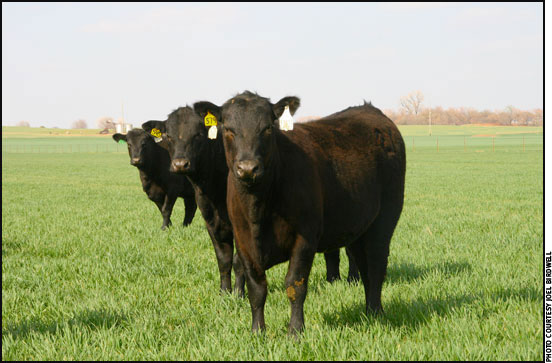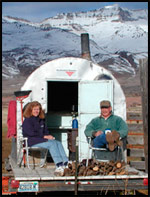MANAGEMENT...

Has Wheat Reached
Hollow Stem Stage?
Early spring growth determines wheat management practices.
As soon as wheat begins its first flush of growth in late winter or early spring, producers might want to start examining plants to determine if the wheat has reached the "first hollow stem" stage, said Jim Shroyer, K-State Research and Extension crop production specialist. This is especially important if planned nitrogen has not yet been top-dressed or if the wheat is being grazed.
First hollow stem is the point at which about a half-inch of hollow stem can first be identified above the root system and below the developing head, Shroyer explained. Why go to the trouble? The first reason has to do with top-dress fertilizer timing; the second, with effects on grain yields of cattle grazing wheat at this stage of growth. Read more.

Ron Torell with his wife, Jackie
Cow Camp Chatter
Bovine grass fever
It happens to cows in mid-April of every year in high-mountain hay-feeding country. Bovine grass fever. Cows will leave dry hay on the feed ground, preferring to chase a tint of green. We certainly cannot blame the cow for her interest in chasing green grass over dry hay. Cows are tired of eating dry hay, and cowboys are tired of feeding it. The promise of green grass is a welcome sight to all.
The tint of green in early spring is no more than a promise of the quality of grass to come. It is inadequate in quantity to meet a cow's elevated postpartum nutritional needs. This results in declining body condition at the most crucial stage, the anestrous postpartum interval. This is the period from calving to first estrus. In addition to the trauma of calving, the uterus is going through an involution process, which is necessary to prepare the cow for rebreeding within 83 days, ensuring she will calve at the same time next year. Peak lactation is occurring, and many of these cows are thin from the past several months of winter-feeding or lack thereof. Read more.
Marry Implants and Quality Goals
In a perfect world, cattle growth promotants would increase marbling, too. Short of that, feeders can strike a balance between grade and gain, implant and marbling levels. Here are four of the top ways:
1. Delay implanting until placing cattle on full-feed.
2. Less-aggressive implant strategy offers better result.
3. Repetition matters, but fewer is not always best.
4. Fit implant strategy to nutrition, type.
Thinking About Summer Calving?
Here are some points to ponder.
A move to summer calving isn't a decision that should be made lightly. But it might be a decision worth considering, suggests Dave Pratt of Ranch Management Consultants. Pratt teaches the Ranching for Profit courses around the country, and offers some advice to ranchers who are pondering a change to their calving season. Read more.
Invasive Species
UK research shows invasive species' abundance similar at native and introduced sites.
Many land managers know firsthand the damage invasive species can do to natural resources, but no one knows exactly why these species, common throughout the world, are able to outcompete native plants. A long-held theory, developed by biologists, hypothesizes that invasive plants are more numerous in introduced sites compared to their native, or home, range, because an ecological change occurs during their invasion that gives them an advantage over native plants. This theory is known as the abundance assumption.
An international team of scientists that included the University of Kentucky (UK) College of Agriculture's Rebecca McCulley tested the abundance assumption on 26 invasive plant species at 39 grassland locations on four continents. Their results found that most species had similar or lower abundances at the introduced sites compared to their home range sites. Read more.

Kris Ringwall
Beef Talk
There is no quick fix to poor bull fertility.
The bull pen can be that behind-the-barn pen that is forgotten as calving gets under way. A careful eye is scanned over the cows from sunrise to sunrise, but the bulls may just be fed. In fact, they may be watching us more than we are watching them.
However, next year's calf crop is on the line, and those bulls need to be ready for bull turnout. At bull turnout, the bull is expected to be physically fit and fertile. From a management aspect, managers need to understand that, without a doubt, neither of these two expectations can be met by attending a two-week short course and coming home with a quick fix. Read more.
New Products
Industry affiliates provide a wide array of products and services to assist you on the farm and ranch. Here's an assortment of new products to hit the market recently.
• Preventing immunity gap in newborn calves
• Verification for preconditioning calves
• Superior visibility for loaders
• Automatic gear-shifting tractor
• Blood-sampling system promotes safety
• This calving book survives laundering
Angus Advisor
Click here for March herd management tips from cattle experts across the nation. Advice separated by region.
[Click here to go to the top of the page.]










